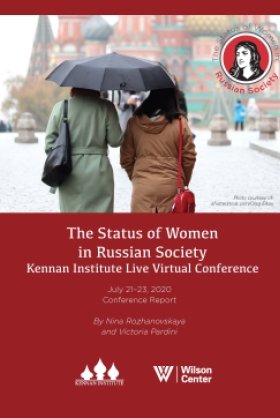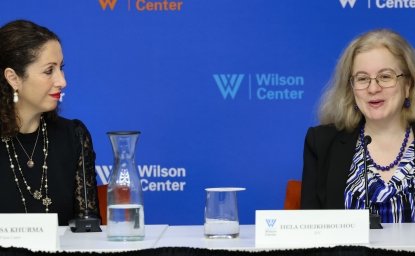The Status of Women in Russian Society | Conference Report


Read this report in Russian here.
Introduction
On July 21–23, a distinguished group of Russian, European, and North American academics and practitioners gathered for a live, virtual discussion of the status of women in Russian society. The conversations focused on the present-day dynamics, challenges, and opportunities associated with six core themes: feminism, human rights and activism, women in politics and public administration, women in the workforce and labor market, family and motherhood, and the problem of gender-based violence and measures to combat it.
More than 70 people, about 60 percent based in Russia, attended the conference, and each of the six virtual roundtables brought together between 35 and 45 participants. Four kickoff speakers, one Western expert and three Russian academics and practitioners, began each discussion with introductory remarks before opening the floor to thoughts, observations, and questions. This structure allowed participants to present firsthand experiences, explore the gap between research and practice, compare Russian and Western academic perspectives, and establish new contacts between scholars of women’s issues and people involved in the subject matter on the ground. Adherence to the Chatham House Rule ensured a frank and uncensored conversation, and the Zoom chat and breakout rooms created an opportunity for less formal exchanges.
This report summarizes the discussions and lists the major takeaway points of the three conference days. It also outlines how the conversation on these important topics can continue in the form of events and publications at the Kennan Institute and beyond. Because of the Chatham House Rule, we omit the names of speakers and commentators.
Roundtable 1: Feminism in Russia
The first roundtable focused on the evolution of feminism and the feminist agenda in Russia. An overview of historical background offered context for subsequent discussions. One speaker outlined similarities and differences between the development of feminism in Russia and in the West in the nineteenth century, emphasizing the more pronounced differences. While women in the Russian Empire were deprived of voting rights, some men faced voting restrictions as well, and women in Russia did retain property rights, unlike in many Western societies of the time. All the same, having no experience with collective action, and largely uninformed about the rights they did have, many women supported the Bolsheviks, who promised them equality and delivered on that promise.
The story of the feminist and women’s movement in the Soviet Union is an interesting and complicated one. Coincidentally, the conference fell near the fortieth anniversary of the expulsion of a group of Leningrad feminists from the USSR for publishing the samizdat magazine Almanac: Woman and Russia. This anniversary serves as a timely reminder of the fact that feminism in Russia is not a phenomenon that emerged in the 1990s as an import from the West but has a much longer history.
In today’s Russia, feminist activism varies depending on organization type and how the different organizations deploy technology to achieve their goals. Newer forms of activism are more adaptable and make full use of social media, while some of the long-standing organizations are disappearing as a result of the country’s conservative turn and loss of international funding. The trend toward less formal feminist organizations is at least partially the result of the shrinking public space for political engagement, but many organizations have adopted creative approaches to fundraising and outreach that have helped lay the groundwork for cultural change and a broader acceptance of feminist ideas.
In public talks aimed at dismantling stereotypes, feminist speakers often find that women themselves tend to shy away from using the word “feminism” and from conversations about discrimination. Domestic violence has moved to a prominent place on the public agenda, but now feminists tend to focus on this problem overlooking other social issues. Among other critiques, the discourse is noticeably heterocentric, even though the LGBTQ+ community faces similar issues related to abuse in relationships. In addition, the fight against the so-called “gay propaganda law” of 2013, which criminalizes “propagandizing nontraditional sexual relationships” to minors, thus effectively criminalizing the public promotion of LGBTQ+ rights in Russia, remains outside the feminist agenda. Some conference participants voiced the need for intersectionality, although another participant later objected, arguing that it dilutes the feminist agenda.
In the discussion, participants reflected on the roots of feminism in today’s Russia, considering the forms of activism that emerged after the 1917 revolution and the problematic role of the Soviet state, under which women arguably suffered less from lack of rights than from the inability to exercise them. Conference participants also contemplated the post-Soviet transformation, when Russian women reevaluated their social roles and embraced some previously unavailable options, such as the role of a housewife. Academic participants noted the absence of “herstory” and the exclusion of gender history from the academic discourse, and lamented the patriarchal state of Russian academia in general. Acknowledging the existing stigma associated with advocating for feminist principles and practices and the fragmentation of the feminist agenda, they welcomed the new forms of activism and the fresh interest in this range of issues demonstrated by younger generation of students.
Roundtable 2: Women in Human Rights and Activism
This roundtable dealt with a range of issues, from various forms of Russian human rights activism engaging women to the role of gender in armed conflict and throughout the subsequent peacebuilding process.
One speaker relied on her vast practical experience in human rights advocacy to conclude that it is, unfortunately, an unsafe endeavor in some parts of Russia, particularly in Chechnya. She nevertheless urged activists not to abandon their efforts, especially where the Russian government is indifferent to local suffering. She offered examples to dismantle the stereotypes that women are always allies of other women and of human rights advocates and that men are always the perpetrators of violence. Rather, she explained, she had met with mothers who were ready to follow religious norms or social expectations at the expense of their daughters’ well-being, while fathers and brothers were ready to defy family and community pressure to protect their daughters and sisters. In Russia, civil society may have “a woman’s face” and the authorities may have “a man’s face,” but protecting women is a job for everyone, and ensuring numerical gender equality does not immediately resolve the human rights violations.
Another hot issue in human rights is Russia’s penal system. It is not surprising that the prison experience, either their own or that of their loved ones, often pushes women toward activism. One can imagine a situation in which a person living in Russia faces a social injustice but the Russian government—federal, regional, or local—is not taking steps to rectify the situation. Understanding that there is no reform because there is no political will turns frustration about everyday grievances, such as poverty or injustice, into motivation for civic activism, which in turn often transforms into political activism. The prison experience can be a powerful catalyst for this transformation.
Linking the first two discussions, a gender studies scholar outlined three main strategies in Russian women’s activism starting from the 1990s: gender-neutral activism, which does not see women’s rights as a separate category from human rights; feminist activism, which does view women’s rights separately; and the work of “socially oriented” organizations, which does not specifically align those organizations’ missions with feminism but instead focuses on helping women. Interestingly, there have been two opposite trends over the last 20 years. One is the convergence of the three types of activism and a shift toward greater gender sensitivity, the other is a trend toward ensuring democratization and civil rights on the premise that the feminist agenda is an organic part of civil rights.
Gender roles change during private and public violence, and both war and peace are gendered processes that need to be addressed in conflict resolution and peacebuilding. One of the speakers outlined the framework, suggested by the US Institute of Peace, that applies three approaches to different conflict experiences, including Russia’s: women in peace and security (engaging women in security matters and peacebuilding), peaceful masculinities (shifting the mindsets and learning new norms and behaviors), and intersecting identities (challenging binary perceptions).
In reflecting on the post-Soviet experience of activism, participants called for the solidarity of Russian women and the solidarity of Russian civil society organizations that would transcend a women’s or feminist movement. The coercive orientation of Russia’s political regime and efforts by conservative (antigender) forces create a context in which such solidarity is absolutely essential.
Roundtable 3: Women in Politics and Public Administration
This roundtable highlighted a conceptual disagreement between practitioners and academics, that is, between politicians and political consultants, on the one hand, and those who study them on the other.
One of the kickoff speakers presented a study that analyzed the representation of women in Russian political bodies at different levels. The speaker described quantitative variations between different regions and municipalities and showed the positive effect of the mixed electoral system, wherein seats are filled both from party lists and from single-mandate districts. She then explained qualitative research, based on twenty-five interviews, which identified a postfeminist combination of autonomy, whereby individuals develop personal strategies to achieve well-being, and exploitation of the patriarchy, whereby female officials find it more beneficial to use the existing system than to show solidarity with the women’s agenda.
It is often easy for both activists and officials to discuss quantifiable things like quotas and the wage gap, even as many less tangible social issues require action. Broken social support mechanisms, the burden of caregiving (which mostly falls on women), excessive public control over motherhood, and the effect of raising children on decreasing a woman’s financial well-being are all emotionally charged problems. One speaker noted that in some way, women are still waiting for “a female version of Alexei Navalny” to formulate all of the demands and consolidate the critical mass.
Another speaker, a politician, disagreed with the academic perspective, arguing that scholars focus on decision-making bodies that are decorative in nature (“made of papier-mâché”) and that a formalized approach to studying politics overlooks the real dynamic. Much of Russian politics and economy is informal, and important decisions often are made outside formal institutions, in spaces that exclude women—such as in men’s restrooms and saunas or on hunting and fishing trips.
While women do not participate in politics strictly to pursue a feminist agenda, social issues offer enough motivation for some women to run for office. Men do not necessarily create artificial obstacles for women, but grassroots-level politics is full of challenges, from fundraising to collecting signatures. Russian municipal councils do have a high share of women, but there was no need for quotas to achieve that; it is enough that these jobs are not very lofty for men to pursue. Ironically, it is sometimes less dangerous to be a woman in Russian “real politics” than to be a man, as (for instance) a female opposition figure is less likely to end up under arrest due to legal provisions that prohibit administrative arrest of pregnant women and women who have children under the age of fourteen.
The post-Soviet shift in attitudes was a backlash against the Soviet vision of equality, and today’s trend is a response to what is perceived as a Western model. Now, all major political parties exhibit different versions of conservatism, and women in Russian politics, consciously or unconsciously, steer clear of the feminist themes to avoid scorn. The problem of the Russian political system is not just the lack of gender representation, it is also an age imbalance. So Russia needs “concentric circles” of women and young people of both sexes running for office in order to create a new political culture. It also needs feminists as allies in pursuit of the social change agenda.
Roundtable 4: Women in the Workforce and Labor Market
The Soviet Union was a pioneer in the labor market integration of women, but the Soviet state prevented women from contesting two elements of gender subordination[1]: distributional inequality, or the gendered division of labor, and the associated status inequality, or the devaluation of work seen as “feminine.” The key insight from the Soviet experience is that, to promote equality, employment needs to be combined with a gender-conscious ideology.
In today’s Russia, women’s employment remains high, but there exists a strong horizontal segregation of employment, where men and women tend to concentrate in different jobs and industries (e.g., construction vs. childcare), as well as strong vertical segregation, where women have limited opportunities for career progression within their organizations or sectors and which results in the pay gap. Russia also has a list of professions legally banned for women in industries considered more risky or intense, including some jobs in chemical production, mining, and shipbuilding industries. Men’s family roles are rewarded publicly and privately, while women are effectively penalized through the doubled workload at home and in a career, in addition to facing employment discrimination and limited career prospects. The trend toward retraditionalization and remasculinization has affected women’s employment options, but public opinion polls offer grounds for cautious optimism that Russian society has not supported a complete return to traditionalism in the workforce.
The new forms of labor deprivation are unrelated to unemployment and impoverishment but have to do with the lack of life and career prospects. Millions of men and women in Russia hold precarious jobs with nonstandard work contracts. Many value such contracts for the autonomy that comes with them, but in the case of women, precarious jobs are often the result of their caregiving burden and the fact that having children makes them undesirable employees.
Russian research and academia have their own interesting dynamic. The share of women in the sciences, which increased in post-Soviet times because of male brain drain and exit, is now in decline again. There is also a deepening gender divide in different science fields, as well as underrepresentation of women from the PhD level up, a situation often described as a “leaky pipeline” to highlight the progressive disappearance of women from academia with each step of the career ladder, especially in STEM fields. These trends affect the livelihoods and prospects of female researchers and academics, but gender imbalance also hurts science itself, while gender diversity stimulates innovation. The international experience offers a variety of ways to improve gender representation in Russian science, from blind reviews to stopping the clock on grant deadlines when women scientists take maternity leave.
Gender imbalance is not confined to wage structures and career prospects. As one of the speakers put it, a male-only prism dominates the Russian public expertise field and tends to offer a distorted view of reality, such that “common good” often implies patriarchal values. At the same time, women’s achievements are absent from public spaces, and many female professionals are in constant search of legitimation and visibility. Hence it is important to “decolonize” the discourse and create platforms, such as the Heinrich Böll Foundation’s “She Is an Expert” project, to help achieve true gender parity, which is not about political correctness but about the quality of work and expertise and the visibility thereof.
There is a widespread perception of inequality as a norm in Russia, so much so that women in the workforce may not even notice discrimination. Those who do notice and refuse to play the prescribed roles often pay the price by facing additional pressures at work, as male colleagues start to see them as bad team players and troublemakers, but international experience indicates that the solidarity of women in leadership positions and those lower down helps prevent discrimination and harassment, both in academia and in other sectors.
Roundtable 5: Family, Reproductive Rights, and Maternal Health
This roundtable discussion took place against the backdrop of a symbolic anniversary: 100 years since the Soviet Union became the first country to legalize abortion as a way to demonstrate socialist equality and enable women to join the workforce. Banned in 1936, abortion was decriminalized again in 1955, this time to prevent women’s deaths from back-alley abortions rather than for the sake of female autonomy, and for a long time it remained the main form of birth control for Soviet women. As a result, it came to represent the lack of choice, so in the early post-Soviet rhetoric, the “Against abortion” slogan actually meant “Against routine abortion” as activists endorsed contraception and supported timed and planned pregnancies.
The issue of reproduction has been central to the political reconstitution of post-socialist countries, and hostile encounters over legality of abortion reflect the cultural anxieties of the last 30 years. Like politicians in other countries, Russian politicians see paying attention to reproduction as a way to express concern over the nation’s future and an illustration of caring about something beyond their own immediate concerns, but their focus is on the “health of mothers and children,” while actual reproductive rights are absent from the government’s discourse and are underrepresented in the Russian feminist discourse, too.
Soviet and post-Soviet Russia experienced immense demographic losses, so it is no wonder that in the 1990s a moral panic resulted from the so-called “Russian cross,” a demographic trend so named because of the intersection of the declining birth rate and climbing death rate on a graph. Leaders link demographics to geopolitical strength, and nationalists worry about ethnic Russians dying out, so church leaders and political leaders have joined efforts to counteract what they see as alien ideas of feminism and a child-free ideology imposed by the West.
In the 1990s, experts and activists succeeded in improving health care, training physicians, and educating the public, managing to decrease risky sexual behavior and improve medical care for women to achieve a 30 percent decline in abortions in favor of contraception. The situation changed when Russia experienced a conservative turn, the funding of NGOs ran out, and a number of legislative and administrative measures were adopted to restrict reproductive choices. Now, Russian women face the pressure of “traditional values” and must deal with an array of challenges, from medical risks (increased maternal and perinatal mortality rates in remote areas, the wider use of C-sections, reduced access to medical abortion) to human rights problems (violation of pregnant inmates’ rights) and poverty (huge alimony debts and insufficient state support of single mothers).
Discussions of institutions reveal variations in gender sensitivity depending on age, class, and nationality. Those that are in a better social and economic position or are located in geographic centers tend to be less sensitive to growing gender inequality because it is outside their sphere of concern, overlooking situations where formal rights exist but are difficult to exercise even within their country of domicile. Conversations with Russian and international students reveal that some understand that the right to individual choice does not compensate for unequal opportunities, realize the injustice potential of the family as an economic unit, and see personal experience as a source of emancipatory alternatives.
Roundtable 6: Gender-Based Violence and Governmental Response
Gender-based violence is too wide a topic to cover comprehensively in one roundtable, so participants focused on just a few aspects. Emphasizing the need to combine international publicity and pressure on Russian legislators with mutual support across Russian regions, they observed that activists need to present a “monolithic” position in the public space and project an alternative message to challenge the “ideal woman” image and conservative rhetoric broadcast by the Russian media.
There are multiple centers across Russia that offer assistance to victims of gender-based violence, and there are projects, like Nasiliu.net, that focus on educating the public and spreading the word to prevent violence. The true scale of the problem remains unclear as, according to activists, there are no reliable statistics, domestic violence is underreported, and its Criminal Code definition is too narrow.
Multiple attempts have been made to pass a law on domestic violence, piggybacking on structural opportunities like an election or a general reform and at the same time making full use of informal politics. Soon after a structural opportunity presented itself in 2013, there emerged a conservative backlash and a worsening of Russia’s relations with the West, which affected the discourse on family and values and led to the decriminalization of domestic violence. Several high-profile cases of abuse drew attention back to the draft legislation, and advocates hope that the new parliament of 2021 will finally pass the law.
Domestic violence is a common problem across the country, but Russia’s North Caucasus regions are a particular hotspot of gender-based violence of some very specific kinds. For instance, studies show that hundreds of girls are subjected to female genital mutilation in Dagestan and Ingushetia, while authorities seem unwilling to prosecute those cases, and research on honor killings in Chechnya, Dagestan, and Ingushetia and analysis of court verdicts indicate victim blaming and the use of “attenuating circumstances” to justify minimal sentences.
The Moscow office of the Heinrich Böll Foundation has a special program in Russia that targets the perpetrators of violence and explores the potential for nonviolent communication, discusses the costs of patriarchy and toxic masculinity for men themselves, and looks for ways in which men can become mediators of cultural change in the North Caucasus. Overall, however, there are few such programs targeting men. At the same time, although they are generally small in scale, one should not underestimate their ripple effect.
There are over 150 crisis centers in Russia, but only a handful are truly active and well-known. Female misogyny, victim blaming, and the lack of solidarity within and between the activist and feminist communities create dividing lines. The coronavirus lockdown, while exacerbating the problem of domestic violence, also pushed Russian activists to unite their efforts and merge their scarce resources. Pressure exerted by conservative forces and the threats that activists face, particularly in the North Caucasus, also call for greater solidarity, including between human rights advocates and feminist activists.
Conference Takeaways
The roundtable discussions focused on complex and diverse topics, but some core themes were repeated throughout the conference.
Conference discussions highlighted the importance of involving both academics and practitioners in conversations about women’s issues, in Russia and elsewhere. It is not uncommon for practitioners in different fields to criticize scholars for being out of touch with what it is happening on the ground. In the case of Russia, independent politicians raise the issue of informal politics, whereby decisions are made outside designated institutions, as it tends to elude the scholarly eye. Here, bridging the gap between research and practice would mean that academics would examine unconventional aspects of the Russian political system and that politicians would borrow some academic prisms and terminology to better comprehend and describe the reality in which they function.
In addition to involving both scholars and practitioners, it is important to bring together different generations of feminists and activists. There were prominent feminists and feminist groups at different stages of Soviet and post-Soviet history, and today’s scholars and activists are not the first generation to study and promote the ideas of feminism in Russia, but the new generation of activists seems to lack some of the knowledge about earlier successes and challenges. This lacuna can be partly explained by the fact that many post-Soviet gender studies centers did not survive Russia’s conservative turn. Both the Soviet and early post-Soviet experiences need processing, and there is a clear need to reflect on Russia’s history and look back at the first feminist organizations and the people who laid the groundwork for today’s scholars and activists.
Intergenerational dialogue between Russian women’s movement veterans and new actors and thinkers can and should be supplemented with transnational dialogue between and among Russian, European, and American scholars and practitioners. Despite the differences between the two countries’ societies and political systems, Russia and the United States face some of the same challenges when it comes to the women’s agenda, and could learn from each other’s experiences.
In the Russian case, it is also vital to look beyond Moscow and St. Petersburg and engage the wide variety of regional experiences and perspectives on women’s issues from across the country. The Kennan Institute’s conference included participants from Ivanovo, Makhachkala, Nizhny Novgorod, Samara, Smolensk, Tomsk, and Tver, but wider geographic representation would enrich the conversation. Furthermore, as one participant noted, it might also be helpful to learn from the work of Holocaust studies and supplement the picture with the voices of direct participants and witnesses, such as clients of crisis centers or former inmates who became activists.
It is not possible to create a comprehensive picture of women’s problems absent the relevant national and historical context. In Russia’s case, it means tracing the history from before the Russian Revolution while also understanding Soviet and post-Soviet developments, the complex ethnic and religious setup of today’s Russian society, and the intricacies of the contemporary political system and regime. The evolution of Russian feminism over the past thirty years and the transformation of feminism into nonfeminism and postfeminism are as interesting as the deeper historical roots of today’s agenda.
Many of the problems raised at the conference are systemic and go beyond women’s issues; solving them will require a cultural shift and political transformation. The Russian conservative backlash is shifting attention from the country’s economic decline and growing inequality to status anxieties and is undermining both traditional and intersectional feminist agendas. Some feminist and women’s rights organizations that used to be seen as a normal part of civil society are now ostracized by the general public. While the pursuit of women’s rights should not be reduced to a fight against specific government policies and legislative initiatives, Russia offers an interesting case for exploring the motivations and strategies of activism and social change in an authoritarian regime.
In light of the wide scope of the discussion and the interest participants expressed in one another’s work, there is a clear need for an ongoing conversation and a deeper exploration of specific topics in smaller online and offline meetings. One of the ideas voiced during the wrap-up session was to create a private online space so that this group of scholars, activists, and practitioners could maintain regular contact, exchange information, and explore the possibility of joint projects.
Another idea briefly discussed during the conference is a book project focusing on the history of the Soviet and Russian women’s movements. To incorporate the lessons learned in this conference, the project would need to offer a historical overview, reflect on the work of the first Soviet feminists, who were marginalized even by other dissidents, recover what is left of the archives and libraries of feminist organizations and gender studies centers, and interview those living late Soviet and early post-Soviet thinkers and activists who laid the groundwork. It would also need to involve younger scholars and activists as co-authors to bridge the generation gap and ensure continuity of the Russian women’s movement.
Because of time constraints, the conference discussions had to omit a variety of problems existing within feminism and activism, but did touch on the complicated relationship between the two. It is no secret that despite a recent resurgence of interest in feminism, the word itself has negative connotations in Russia, and female activists often shy away from that label, even if their practical work reflects feminist ideas. Still, as many of the conference participants emphasized, the key to success lies in solidarity, including solidarity across gender divides and ideological lines. One can argue that it is time for female activists to embrace feminism, for men to become true allies in pursuit of women’s rights, and for feminists to join the fight for wider social change.
[1] According to terms identified by Dr. Nancy Fraser (2007).
Authors



Kennan Institute
After more than 50 years as a vital part of the Wilson Center legacy, the Kennan Institute has become an independent think tank. You can find the current website for the Kennan Institute at kennaninstitute.org. Please look for future announcements about partnership activities between the Wilson Center and the Kennan Institute at Wilson Center Press Room. The Kennan Institute is the premier US center for advanced research on Eurasia and the oldest and largest regional program at the Woodrow Wilson International Center for Scholars. The Kennan Institute is committed to improving American understanding of Russia, Ukraine, Central Asia, the South Caucasus, and the surrounding region through research and exchange. Read more

Explore More
Browse Insights & Analysis
How Education Can Empower Young Women in MENA

Empowering the Changemakers of Today: Young Women

